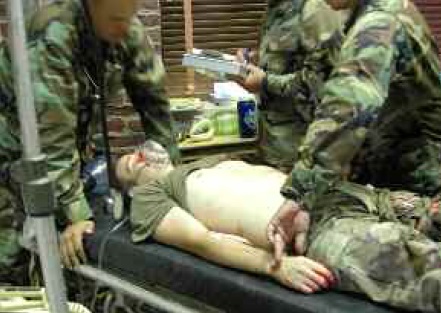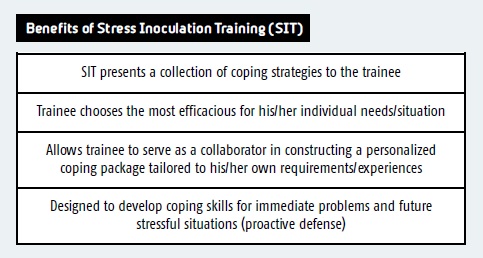➣ By Nancy Ahmann

Figure 1:Military medics practice lifesaving procedures on an actor with simulated injuries.
Stress Inoculation Training (SIT) is often the umbrella term used to represent a collection of coping strategies provided to the trainee. Often thought of as “mental armor,” SIT helps to “inoculate” individuals to future potentially traumatizing stressors, teaching them to psychologically deal more effectively with the stressors. In 1988, a National Research Council study on enhancing military performance found that when a person is given knowledge of future events, stress surrounding those events is then reduced. In general, this occurs because stress is associated with a new, novel task. Stress training therefore renders the task less novel and improves the trainee’s self-efficacy, which in turn improves performance.
The goal of SIT is not to eliminate stress but to learn to respond adaptively to stressful situations. The Virtual Reality Medical Center (VRMC) develops immersive three-dimensional computerized virtual environments (VEs) for SIT for combat medics and other first responders.
During Virtual Reality stress inoculation training (VR-SIT), military personnel “experience” highly stressful situations in a VE while being physiologically monitored. Repeated exposure enables personnel to gradually become desensitized to stimuli that may initially elicit such strong physiologic arousal that performance is impeded (i.e., “freezing in the line of fire”) and psychological trauma is more likely.
In SIT, individuals are provided with a tool kit of coping strategies, which allows them to construct a personalized coping package and choose those strategies most efficacious for their individual needs and for the particular situation. These skill sets are developed with the goal of helping with immediate needs as well as future stressful situations in a proactive defense against trauma. Some of the traditional components used in an SIT regimen include didactic teaching, problem solving, cognitive restructuring, imaginal rehearsal, behavioral rehearsal, relaxation training, selfinstruction, self-monitoring, and selfreinforcement.

In providing over 7,000 treatment sessions for a variety of psychological disorders through a combination of cognitive- behavioral therapy and physiological monitoring over the past 15 years, investigators at VRMC have noted that successful treatment of stress and anxiety- related disorders is achieved through skills-based exposure training to increasingly stressful situations. This training allows the patient or trainee to over-learn coping skills and develop a sense of mastery, with the ultimate goal of improved performance and self-confidence in one’s ability.
VRMC’s Student State Assessment, a three-year study funded by Defense Advanced Research Projects Agency (DARPA) completed in July 2005, included a combat medic training scenario in which medics received SIT training using a computerized VE and, separately, VRMC’s Injury Creation Science (ICS) simulator prototype. The prototype employed prosthetics to simulate a number of battlefield injuries on human actors. In these scenarios, injuries were simulated with dynamic “bleeding” wounds. In addition, trainees were able to cut the “skin,” insert a chest tube, and stitch the wound closed. Participants said it was the most intense, realistic training they had ever received.
Now VRMC is improving the injury simulation technology to provide this advanced training for medics in front line care, both in terms of hands-on medical instruction and stress management. The next generation of ICS is focused on the development of prosthetic devices that allow medical specialists to practice actual emergency medical procedures with simulated organs and tissue. These procedures include bypassing a compromised airway, inserting an intravenous port, preventing blood loss as a result of arterial and venous wounds, dressing burns, and expanding a collapsed lung. Other injury simulation capabilities are currently under development.
The VRMC team believes that an SIT component may be equally important to the acquisition of appropriate medical triage and trauma training skills. Most medical training does not include a stress-hardening component, even though reports of high levels of stress and Posstraumatic Stress Disorder (PTSD) in medical personnel makes evident the need for improved attention to this growing problem. Although other groups are developing training programs for psychological resilience in military personnel (e.g., Battlemind, Army Center for Enhanced performance/ ACEP, Warrior Reset), there remains a division between these concepts and skills-based (hands-on) medical training. VRMC’s approach is to blend SIT with skills-based medical training with the added component of novel, highly realistic injury simulation technology (e.g., ICS). The intent is not to replace other programs but to build upon and potentially integrate these technologies for a more comprehensive and effective medical training experience.
VRMC foresees this type of fully-immersive, customizable training used not only to enhance the skills of military personnel, but also others who perform in high-stress situations (doctors, emergency responders, etc.). Finally, it is hoped that this type of training can act as a preventative measure against PTSD and other stress-related reactions.
Nancy Ahmann
Virtual Reality Medical Center
U.S.A.
nahmann@vrphobia.com
www.vrphobia.com
About Brenda Wiederhold
President of Virtual Reality Medical Institute (VRMI) in Brussels, Belgium.
Executive VP Virtual Reality Medical Center (VRMC), based in San Diego and Los Angeles, California.
CEO of Interactive Media Institute a 501c3 non-profit
Clinical Instructor in Department of Psychiatry at UCSD
Founder of CyberPsychology, CyberTherapy, & Social Networking Conference
Visiting Professor at Catholic University Milan.









